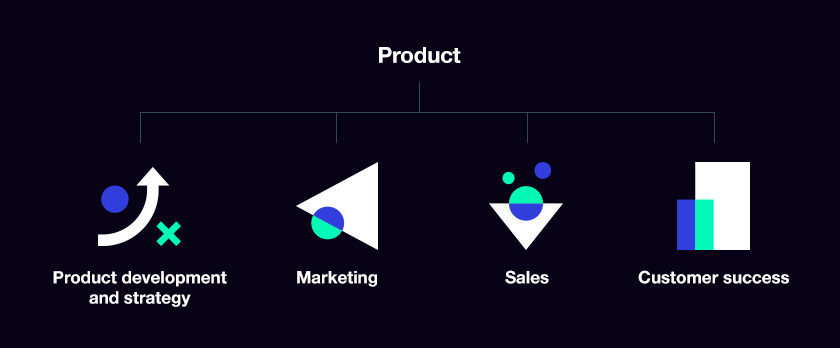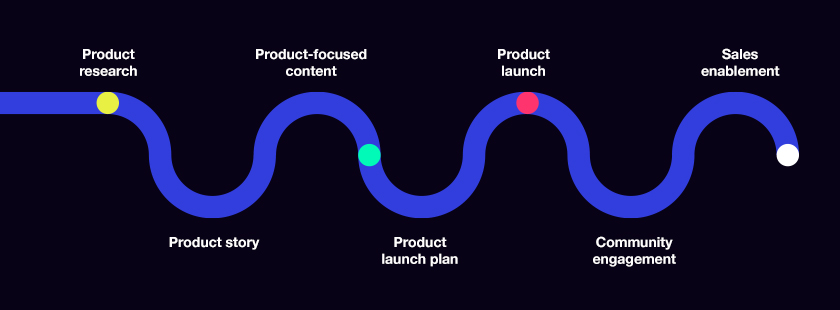
What is product marketing and why is it important for success?
A guide to the key principles of product marketing, what it involves, and how it delivers for organizations.
In the past few years, a relatively new discipline has emerged, bringing together aspects of product strategy, sales, customer success, and marketing. Product marketing is being embraced by B2B, tech, and—increasingly—B2C organizations. In this article, we’ll explore what product marketing involves, why it has taken off, and the essential steps to build a strong product marketing strategy.
The rise of product marketing
Product marketing has gained prominence, especially in B2B tech and software-as-a-service (SaaS) companies, in response to a real and pressing need.
Brand marketing teams were doing a great job of focusing on overall positioning and brand strategy. Content marketing provided a strong ongoing pipeline for attracting prospects and nurturing leads. But as the market evolved, it became clear something was missing.
Companies were developing ever more sophisticated offerings and ramping up their product development. The need grew for a hybrid function that was focused on individual products, to give each one its best possible chance of success in an increasingly crowded market.
What is product marketing?
A simple enough question. However, the answer is a bit more complex than just ‘marketing a product’

Product marketing actually starts with the customer. It is closely concerned with understanding the buyer and their journey, using this information to build a blueprint for positioning, targeting, launching, promoting, driving demand, encouraging adoption, and ensuring success of a product.
“Product marketing, when done correctly, is usually in charge of three things: Deciding a soon-to-be-released product’s positioning and messaging; launching the product and making sure users (in B2C) or customers and salespeople (in B2B) understand its value; driving demand and usage of the product.”
Casey Winters, Chief Product Officer, Eventbrite
A useful way to think of product marketing is that it sits at the intersection of four functions:
- Product development and strategy
- Marketing
- Sales
- Customer success
Now, let’s look at how product marketing is relevant to each of these.
- Product development and strategy
Product marketing helps to shape the product strategy by building an intimate knowledge of the target personas, their goals, needs, and challenges, and how they are using existing products. - Marketing
Defining and researching the target market, and developing the most appropriate positioning and messaging, and building a go-to-market strategy are central to product marketing. - Sales
Product marketing is closely aligned with sales, ensuring teams are fully equipped with the knowledge and sales enablement assets they need to sell the product effectively. - Customer success
Product marketing goes beyond getting the product out there; it keeps a close eye on how customers are using it, gathering insights to optimise and improve continuously.
Why is product marketing important for success?
Launching new products successfully—and marketing existing ones—is more challenging than ever. In a crowded and competitive market, strong product marketing often means the difference between fading into the background, and creating an impact.
Paul Connor of We are Product Marketing, a collective sharing insights from within the product marketing professionals, maps out three vital roles played by the discipline:
- Product marketing supports the Sales-Customer relationship
- Customer research and development
- Sales training on customers
- Buyer personas
- Go-to-market strategy
- Positioning and messaging through marketing and sales collateral
- Competitor research
- Product marketing supports the Product-Customer relationship
- Customer insight and user interviews
- Validating product market fit
- Gathering customer feedback on product
- Positioning and messaging through website and product
- Externally facing communications on product updates and changes
- Competitor research
- Product marketing supports the Product-Sales relationship
- Sales training on product
- Sales insights for product teams
- Gathering sales feedback on product
- Internally facing communications on product updates and changes
So as we can see, product marketing provides an essential bridge between aspects of product, sales, marketing, and customer experience.
However, it is far more than just a go-between. Product marketing is a highly effective approach that puts the buyer and the product firmly at the centre of the process. All efforts are configured around the successful launch, promotion, sale, and adoption of products, giving product marketing a pivotal role in delivering commercial success.
Essential steps for effective product marketing
So now that we’ve covered what product marketing is and why it’s important, how do you build an effective product marketing strategy?

Hubspot identifies seven essential steps that an effective product marketing process should follow, after establishing the fundamental groundwork, which is a detailed understanding of the buyer persona:
- Product research
Bring product marketing together with the product development team to test and research the product both internally and externally. - Product story
Develop strong positioning and messaging to tell the story of the product: who it helps, what problem it solves for them, why it is different from anything else on the market. - Product-focused content
Create the content assets that will best communicate and promote the product, including marketing copy, web content, case studies, landing pages, emails and sales collateral. - Product launch plan
Document the launch plan in detail, creating a roadmap of actions, roles, and responsibilities so that every step is clear and ready to be set in motion. - Product launch
Focus efforts on making sure the ‘big reveal’ goes smoothly. Bring the team together to coordinate activities and troubleshoot any emerging issues. - Community engagement
Engage with partners, influencers, existing customers, and online commentary to amplify ‘buzz’ and drive greater awareness around the product launch. - Sales enablement
Make sure the sales team is fully briefed on all product messaging, positioning, and strategy, as well as equipping them with product-focused assets and collateral to support their efforts.
Conclusion: Product marketing answers the question
In today’s competitive environment, every company, whether B2B technology, SaaS, or B2C, faces the pressing question: How do we give each of our products the best possible chance of achieving sustained success?
Effective product marketing is the answer. It starts with developing a detailed understanding of the buyer personas, builds an insight-driven go-to-market strategy, launches the product, and then works to enable sales, encourage adoption, and drive ongoing customer success.
Key takeaways
- Product marketing has emerged and grown as more crowding in the B2B technology and SaaS space made it harder for individual products to cut through the noise.
- Product marketing is about understanding the buyer and their journey, and using this to build effective go-to-market strategy.
- Product marketing lies at the intersection between product development, marketing, sales, and customer success.
- Product marketing supports the Sales-Customer relationship, the Product-Customer relationship, and the Product-Sales relationship.
- An effective product marketing process incorporates research, positioning and messaging, content production, launch planning, product launch, community engagement, and sales enablement.

